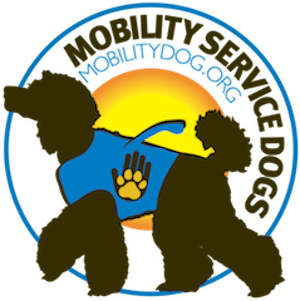Your Dog's Digestive System
Two Happy Service Dogs (Courtesy: MobilityDog.org)
You know a lot about the outside of your dog: her beautiful coat, lovely eyes, and fetching smile. But how well do you understand what goes on inside your pooch? The functioning of her digestive system has a major influence on her health and well-being. In some ways, her internal workings resemble yours. In other ways, however, there are important differences between the digestive processes of canines and humans.
A Beautiful Gray and White Service Dog Poodle (Courtesy: MobilityDog.org)
How Your Dog’s Digestive System Resembles Yours
Same Basic Components
A dog’s digestive system comprises four main parts:
The mouth and esophagus.
The stomach (the small and large intestines), and the colon.
A human’s digestive mechanisms are basically analogous. However, what occurs from point A to point B differs between the two species.
Dietary Similarities
Modern dogs are considered omnivores, just as humans are. Don’t be misled by commercials that suggest your dog should eat like her wild wolf ancestors (or contemporaries). Whereas wolves live on a carnivorous diet in the wild, millennia of domestication have enabled dogs to digest and make use of plant-based nutrients. There is no benefit in searching out grain-free food for normal dogs.
Indigestion, Heartburn and Probiotics
Dogs can suffer from indigestion and heartburn, just as humans do. In a fasted state, dogs’ stomach acids are similar to those found in humans. After eating, however, dogs produce far more acid than we do. Dogs and people can both benefit from antacids. However, before giving your dog an over-the-counter antacid, check with your veterinarian. You do not want to risk potential drug interactions or side effects.
Similarly, Princess may benefit from a probiotic addition to her diet. These boost digestive health by introducing beneficial bacteria into the digestive system. Again, check with your vet to make sure any such new additions to her diet are safe.
A White Poodle Service Dog Meeting a Man (Courtesy: MobilityDog.org)
How Your Dog’s Digestive System Differs from Yours
Different Chewing Motions
The human jaw can move both up and down and side-to-side, enabling us to cut through our food and grind it. A dog’s jaw, in contrast, can only move up and down. While dogs and humans are both omnivores, your dog’s manner of eating resembles her carnivore ancestors. Human jaw action, in contrast, reflects our herbivorous tendencies.
More Stomach Acid
How can dogs eat disgusting things they find on sidewalks, while humans can’t even stomach day-old fish? Credit the highly acidic environment in a dog’s stomach. The canine stomach produces about 100 times the amount of acid produced by humans. This extreme acidity kills off many pathogens before the stomach contents move into the intestines. High acid content also enables dogs to digest chunks of food that would challenge a human’s digestive capability. This is helpful since, as we learned, dogs can’t chew as well as humans and so swallow bigger pieces of food. Food tends to remain in a dog’s stomach for a comparatively longer time, which lets the stomach acid do its work.
Cholesterol Not a Problem – BUT Obesity Is!
Your physician may advise you to lower your cholesterol level, but your vet will never express the same concerns about your pooch. Cholesterol does not have the same effect on the canine heart and blood vessels. Moreover, their digestive systems are designed to accommodate animal fat.
Dogs do resemble humans from suffering health threats related to obesity. The American Kennel Club reports that 56 percent of dogs in the U.S. are overweight or obese. Obesity is linked to a whole list of health issues, including:
Arthritis.
Chronic kidney disease.
Bladder/urinary tract disease.
Liver disease.
Low thyroid hormone production.
Diabetes.
Heart failure.
High blood pressure.
Cancer.
Obesity is not just a cosmetic issue – it’s a major health concern for man’s best friend.
Learn how to tell if YOUR dog is Fat! (AKC.org)
Poop Tells a Tale
You can learn a lot by observing your dog’s poop. Diarrhea is one obvious sign, often brought on by “adventurous” eating. When it lasts just long enough to eliminate the dubious snack, the problem is probably minor. If symptoms persist for several days, or blood appears in the stool, it’s time to see the vet. Parasites, bacteria, and viruses may be the cause. It's also wise to observe your dog’s poop schedule. Persistent constipation may also indicate a health issue.
Dogs are amazing digestive machines, able to consume and process a wide variety of foods. However, they can be indiscrete in their habits, eating things they shouldn’t and consuming too much of what they should. Hence, it’s our job as their guardians to see they take in healthy amounts of nutritious foods and avoid noshing on a tempting chicken sandwich they found in the parking lot!



